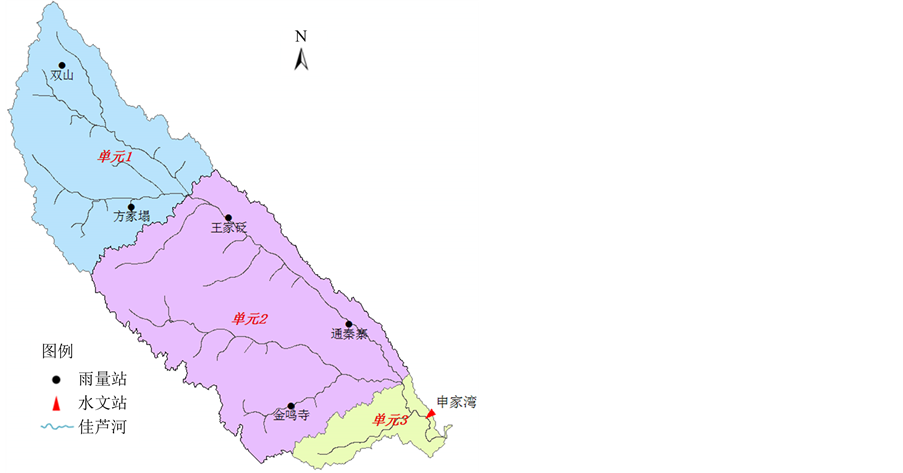摘要:
选择黄河中游山陕区间右岸的一级支流佳芦河为研究对象,采用入黄水文站申家湾1978~2014年的洪水资料,以霍顿下渗能力曲线为基础,结合ArcGIS,分析下渗能力,建立产汇流模型,并进行历史典型洪水模拟。用流域实测降雨量、径流量及前期影响雨量等资料,分析佳芦河下渗能力,建立f~W
0~F
t关系,计算出佳芦河流域稳定下渗率为3.1 mm/h。产汇流模块由蒸散发、产流、坡面汇流和河道汇流共四部分组成,分别采用瞬时单位线法和马斯京根法研究坡面汇流和河道汇流,求出产汇流参数。用率定的产汇流参数对典型洪水进行模拟,模拟效果较好,平均洪峰相对误差约为8.3%,洪峰误差均在预报允许范围之内,平均峰现误差约为0.05小时,平均确定性系数为0.77。
Abstract:
Flood data from 1978 to 2014 at Shenjiawan hydrology station, Jialuhe basin located in the Shanxi-Shaanxi Region of the middle Yellow River, are selected in this study. Based on the Horton infiltration capacity curve and ArcGIS, the stable infiltration rate is calculated, and the runoff yield and conflux model is established to simulate history floods. The observed rainfall, runoff and antecedent precipitation are used to analyze the infiltration capacity, and the stable infiltration rate is 3.1 mm/h through the relation of f~W0~Ft. The watershed runoff yield and conflux model is composed of four parts, among which, the overland flow module adopts instantaneous unit method and the river flow module adopts Muskingum flow algorithm. The history flood simulation results are good: the average error of peak time is about 0.05 hour; the error of peak discharge is in the forecasting allowable range, and the deterministic coefficient is 0.77.
1. 引言
流域产汇流研究是水文学的一个重要研究课题,黄土高原的超渗产流研究对水文预报、降雨径流模拟等尤为重要。本文在霍顿下渗能力曲线和ArcGIS的基础上,建立佳芦河流域产汇流模型,率定出一套比较合理的产汇流参数。
2. 研究区及其基础数据
2.1. 研究区概况
佳芦河是黄河的一级支流,位于黄河中游府谷至吴堡区间的西侧、黄土高原毛乌素沙漠南缘,属超渗产流区 [1] [2] [3] 。佳芦河入黄控制站为申家湾水文站,设立于1956年,控制面积1121 km2。流域内有双山(1953)、方家塌(1977)、王家砭(1953)、通秦寨(1977)和金明寺(1966)共5个雨量站(图1)。
2.2. 单元划分
本次基于ArcGIS建立分散性水文预报模型,即将全流域划分为若干个单元分别进行产水计算。单元划分原则:每个单元尽量为一闭合流域,每个单元内至少有一个雨量站。将佳芦河流域划分为3个单元(图1),各单元地理参数见表1。
2.3. 基础资料
避开桃汛期,挑选申家湾水文站1978~2014年系列历年6~10月的年最大洪峰流量,计算可得均值为420 m3/s;历年洪峰流量大于均值的洪水均入选;对于年最大洪峰流量小于均值的年份,选取该年洪峰流量最大的那场洪水。共选取佳芦河流域洪水37场,计算历史洪水特征值。
3. 霍顿下渗能力曲线分析
3.1. 采用方法
(1) 前期影响雨量
如前、后两日连晴,前期雨量计算公式为 [4] [5] :
 (1)
(1)

Figure 1. River system and station layout in Jialuhe basin
图1. 佳芦河流域水系和站网分布情况

Table 1. Geographical parameter of each unit in Jialuhe basin
表1. 佳芦河流域各单元地理参数
式中: ,t时一日后的前期影响量(mm);
,t时一日后的前期影响量(mm); ,t时的前期影响量(mm);K,土壤含水量的日消退或折减系数。
,t时的前期影响量(mm);K,土壤含水量的日消退或折减系数。
如果在t日有降雨Pt,但未产流,则 ;如果在t日有降雨Pt,产生径流Rt,则
;如果在t日有降雨Pt,产生径流Rt,则 。前期影响雨量Pa的值不应大于流域最大蓄水量WM,所以当计算的Pa值大于WM时,取WM作为该日的Pa值。K为常系数,一般取0.85左右。
。前期影响雨量Pa的值不应大于流域最大蓄水量WM,所以当计算的Pa值大于WM时,取WM作为该日的Pa值。K为常系数,一般取0.85左右。
(2) 霍顿下渗公式
霍顿下渗能力曲线方程为 [6] [7] [8] :
 (2)
(2)
式中:f,下渗率(mm/h);fc,稳定下渗率(mm/h);f0,初始下渗率(mm/h);t,时间;k,反映土壤下渗率递减特性的指数。
霍顿累积下渗曲线公式为:
 (3)
(3)
(3) 稳定下渗率
初始下渗率f0的大小与初始土壤含水量W0相关:W0越小,则f0越大;当 时,
时, ,为最大起始下渗能力;当
,为最大起始下渗能力;当 时,
时, ,为稳渗率。选用暴雨以后的洪水资料,近似地认为
,为稳渗率。选用暴雨以后的洪水资料,近似地认为 ,降雨的损失主要是稳定下渗率,可按下式求得fc,即:
,降雨的损失主要是稳定下渗率,可按下式求得fc,即:
 (4)
(4)
式中:P为次洪降雨量;R为次洪径流量; 为降雨历时。
为降雨历时。
3.2. 计算结果
用实测降雨量、径流量及计算的前期影响雨量等资料,分析佳芦河流域的下渗能力,得到f~W0~Ft关系(图2),并计算出流域稳定下渗率为3.1 mm/h。
4. 产汇流模型
4.1. 模型结构
所建流域产汇流由蒸散发模块、产流模块、坡面汇流模块和河道汇流模块共四部分组成(图3)。
蒸散发模块采用双层蒸散发模型,产流模块采用一般性产流模型,坡面汇流模块采用纳须瞬时单位线,河道汇流模块采用马斯京根分段连续演算法 [9] [10] 。
产汇流模型结构图中:EA,上层蒸发量,mm;WA,上层土壤蓄水量,mm;EAM,上层土壤蒸发能力,mm;WAM,上层土壤最大蓄水量,mm;EB,下层蒸发量,mm;WB,下层土壤蓄水量,mm;EBM,下层土壤蒸发能力,mm;WBM,下层土壤最大蓄水量,mm;B,抛物线指数;α,系数,反映流域特性影响,由历史资料率定;b,指数,反映非线性影响,由历史资料率定;n,线性水库个数;k,线性水库的蓄泄系数。
相应于Qm的河段平均流速V无法直接测得,可通过建立Qm与V的经验关系获得,关系式为:
 当
当 时 (5)
时 (5)
 当
当 时 (6)
时 (6)

Figure 2. Relationship of f~W0~Ft in Jialuhe
图2. 佳芦河流域f~W0~Ft关系
式中:V1、V3,相关线在双对数座标上的截距;V2、V4,相关线在双对数座标上的斜率;Qm,洪峰流量,m3/s;QV,相关线转折点处的流量,m3/s。
流量比重因子X 随流量大小而变化,应用时须进行非线性处理。X与Qm的经验关系式为:
 当
当 时 (7)
时 (7)
 当
当 时 (8)
时 (8)
式中:X1、X3,相关线在双对数座标上的截距;X2、X4,相关线在双对数座标上的斜率;QX,相关线转折点处的流量,m3/s。
4.2. 计算结果
(1) 马斯京根法汇流参数
利用历史实测流量成果数据,根据式(5)~式(8)做拟合曲线求取河道汇流参数,见表2。
(2) 产汇流参数率定及洪水模拟
利用1978~2014年洪水进行模拟,对佳芦河流域的产汇流参数进行率定,结果见表3、图4。
(3) 精度评定

Figure 3. Model structure of watershed runoff generation and concentration
图3. 流域产汇流模型结构

Table 2. Confluence parameter of Muskinggum method in Jialuhe basin
表2. 佳芦河流域马法汇流参数

Table 3. Runoff yield and concentration parameter in Jialuhe basin
表3. 佳芦河流域产汇流参数

Figure 4. Flood simulation in 1986 in Jialuhe basin
图4. 1986年佳芦河洪水模拟

Table 4. Accuracy assessment of flood simulation in Jialuhe basin
表4. 佳芦河流域率定参数精度评定
对佳芦河流域产汇流参数进行精度评定,见表4。历史洪水的模拟效果较好,平均峰现误差为−0.05 h左右,平均洪峰相对误差约为8.3%,以洪峰优先原则来看,洪峰误差均在预报允许范围之内,平均确定性系数为0.77。
5. 结论
(1) 选取黄河中游山陕区间右岸的一级支流佳芦河为研究对象,采用1978~2014年入黄水文站申家湾的洪水资料,基于霍顿下渗能力曲线,建立流域f~W0~Ft关系,通过分析计算得出佳芦河流域的稳定下渗率为3.1 mm/h。
(2) 构建产汇流模型,分别采用瞬时单位线法和马斯京根分段连续演算法研究坡面汇流和河道汇流,产流模块采用一般性产流模型,求出产汇流参数。用率定的产汇流参数对历史洪水进行模拟,模拟效果较好,洪峰误差均在预报允许范围之内,平均确定性系数为0.77。
基金项目
国家重点研发计划课题(2016YFC0402401)。